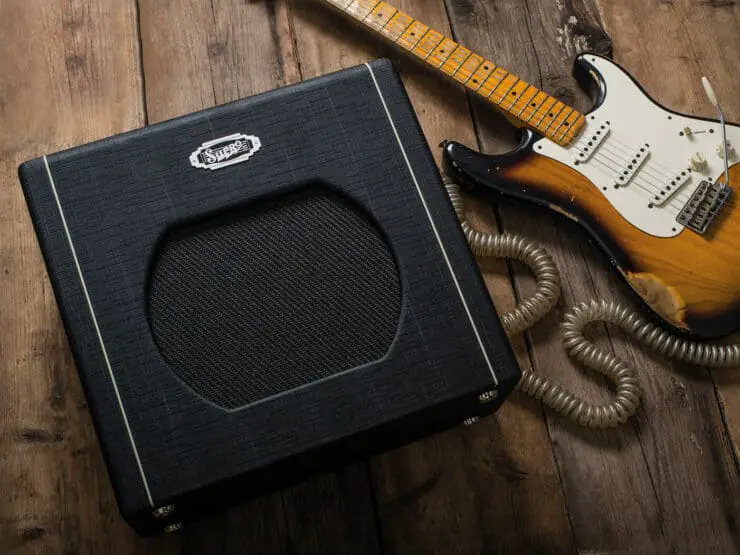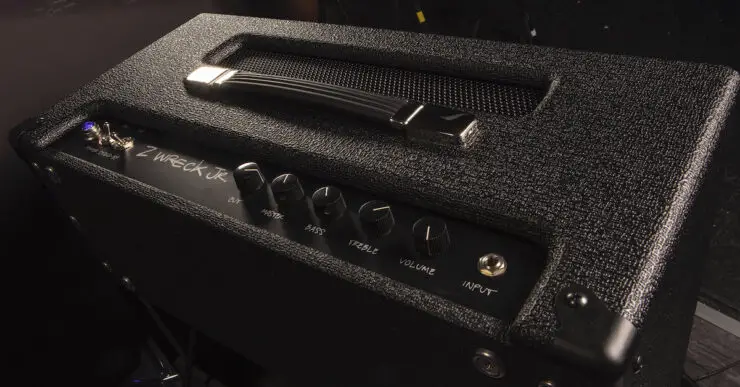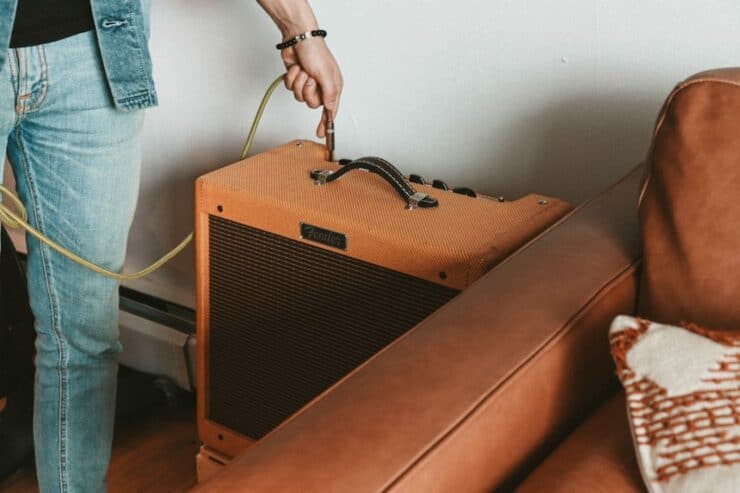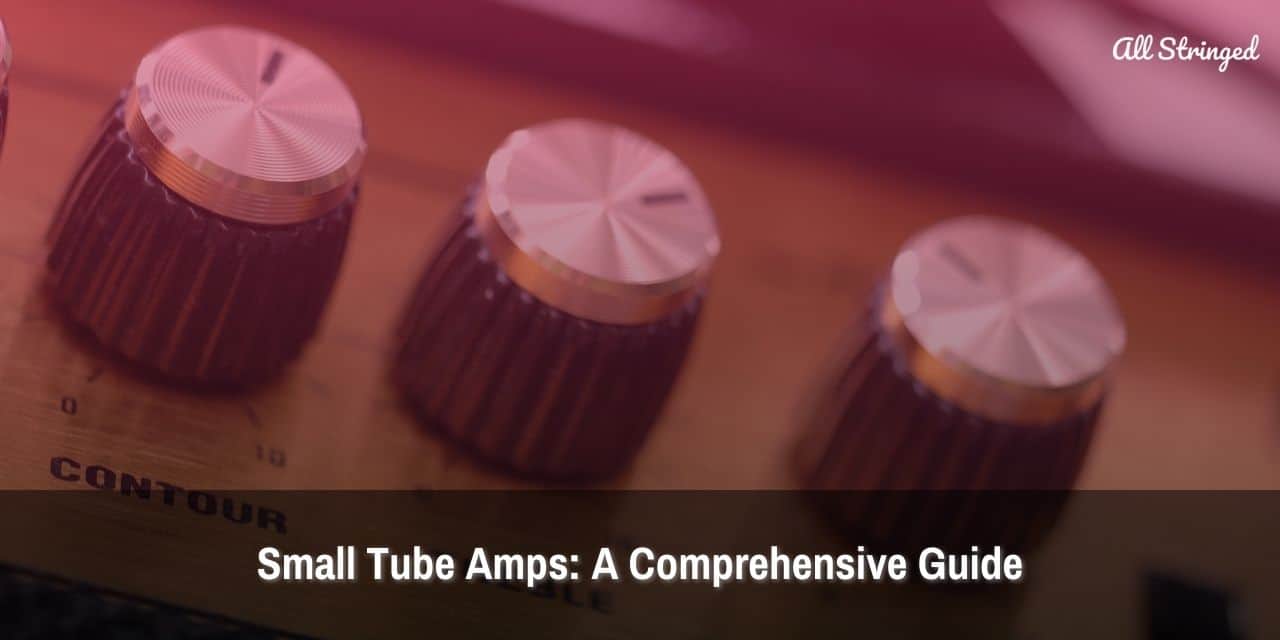Welcome guitar players! If you’re looking for a comprehensive guide to small tube amps, then you’ve come to the right place. In this article, we’ll cover the basics of small tube amps, from their definition, the benefits they provide, the different types to choose from, selection tips, and budget considerations. So, if you’re ready to take your guitar playing to the next level, then let’s get started!
What is a small tube amp?
Many musicians are often in need of a smaller practice amp or something that has less volume so that they don’t disturb the neighbors. There are many mini amp options available on the market, but the smaller options happen to be solid-state amps since the technology is easier to miniaturize. For many music connoisseurs, a solid-state amp is just not an option. Some musicians have a liking for the warm, vintage tones that an analog amp and nothing else can provide.

Luckily, in the modern age, there are many smaller options that are becoming available at a reasonable rate to satisfy the needs of tube amp lovers who need something that has less of a footprint.
A small tube amp, just like the description suggests, is a tube amp that has a much smaller size. The tubes themselves and the circuitry will be much smaller, and so will the cabinet that it is housed within. Tube amps generate heat as they get warm through constantly playing. This is why you need some extra space or a cooling method implemented, especially if you’re playing in a more compact model. Generally, they’ll be ported or open-backed to ensure low ends are dealt with capably and are letting air into it.
>>> Click here to read our review about the Top 15 Best Small Tube Amps <<<
It is worth noting for those musicians who haven’t played with a tube amp that they’ll need breaking in. The sound that you’ll get from your brand-new small tube amp will not be the general sound capability of the amp. In fact, it will take a few hours of playing to warm up to its potential. Once you have broken in, you’ll get the rich, buttery warmth that is synonymous with traditional analog amps.
Benefits of a small tube amp
Small tube amps are quite popular and beloved by musicians of all experience levels for their unique sound and practicality. Despite their modest power and size, small tube amps will offer a wide range of benefits, which make them a tremendous choice for both amateur musicians and seasoned professionals alike.
There are many reasons why you might want to go for a small tube amp, perhaps you’re specifically interested in low-watt guitar amps, or maybe you’re trying to lower the decibels in an effort to be a good neighbor and get away from the noise laws in your state. Here are some of the benefits of using a small tube amp and why they are a great investment –
#1. Portability
One of the most significant benefits of small tube amps is their portability. They are lightweight and compact, making them easy to carry to gigs, rehearsals, or anywhere else you need to play. Small tube amps are perfect for musicians who are always on the move, as they can be easily transported in a car or on public transport without taking up too much space.
The best small tube amps will not only deliver a lower output, but they’re also easier to carry around. Anyone who has owned a high output all tube amp will know that they can sometimes be quite strenuous to transport.
#2. Affordability
Small tube amps are often more affordable than their larger counterparts, which makes them an excellent option for musicians on a budget. While they may not have the same power as larger amps, they still offer the same distinctive tube amp tone that many guitarists love. Small tube amps are also a great option for beginners who want to experiment with different sounds without breaking the bank.
#3. Unique Sound
Small tube amps have a unique sound that many guitarists find appealing. The natural distortion and warm, rich tones produced by a tube amp are highly sought after by musicians looking to achieve a classic rock or blues sound. Small tube amps are ideal for recording as they offer a wide range of tonal options that can be adjusted to suit any style of music.
If you have to play at bedroom levels, crave an authentic tube tone, and don’t want to settle for a digital modeling amp or a solid-state amp, then a small tube amp should be on top of your wish list.
#4. Easy Maintenance
Small tube amps are easier to maintain than larger amps, which often require more extensive repairs and maintenance. The tubes in small amps are also easier and less expensive to replace, making it easier to keep your amp in good working order. Additionally, smaller amps generate less heat, which reduces wear and tear on the components and prolongs the lifespan of the amp.
#5. Versatility
Despite their small size, tube amps offer a surprising amount of versatility. Small tube amps can be used for a range of different styles, from jazz to rock to blues. They are also highly responsive to the player’s touch, allowing musicians to control the amount of distortion and tone produced by the amp simply by adjusting their playing style.
>>> Click here to read more about Guitar Amps <<<
Different types of small tube amps
Small tube amps are a fan favorite among guitarists due to their warm, rich tone, and unique sound. These tube amps are available in a wide variety of sizes and configurations, while also offering different features and specifications. Here are the different types of small tube amps available on the market.

#1. Practice amps
Practice amps are small tube amps that are designed for home use and practice sessions. These amps usually deliver a power output of less than 10W, which makes them ideal for playing instruments at low volumes. Practice amps generally come with a single channel, a single speaker, and a basic set of controls. This type of amp is perfect for beginners or guitarists who are looking for an amp for personal use.
#2. Head and cabinet
Head and cabinet amps consist of two separate pieces – a small tube amp head and a speaker cabinet. The small tube amp head will consist of the preamp, power amp, and controls. Meanwhile, the speaker cabinet will contain the speakers. Head and cabinet amps offer a lot more flexibility than combo amps, as you’ll be able to mix and match different heads and cabinets for achieving the desired sound. These amps are quite popular among budding musicians as they’re very easy to transport and set up.
#3. Combo amps
Combo amps are a single unit that combines the amp and the speaker in one package. These amps are quite popular among guitarists since they’re pretty easy to use and provide a wonderful sound. Combo amps come in a wide variety of sizes and power outputs, which range from practice amps to larger amps that have more than 50 watts of power. Combo amps will be perfect for beginners, practicing at home, and small gigs.
#4. Low-wattage Amps
Low-wattage amps are small tube amps with a power output of fewer than 15 watts. These amps are designed to produce a warm, rich tone at lower volumes, making them ideal for home use or recording. Low-wattage amps are perfect for guitarists who want the tube amp sound without the volume.
#5. Vintage Amps
Vintage amps are small tube amps that were made before the 1980s. These amps are popular among guitar players because of their unique tone and character. Vintage amps are often more expensive than modern amps, but they offer a sound that is hard to replicate with newer technology.
#6. Boutique Amps
Boutique amps are small tube amps that are handmade by independent builders. These amps are often expensive, but they offer a high level of craftsmanship and attention to detail. Boutique amps are popular among guitarists who want a unique sound and are willing to pay a premium for it.
How to choose a small tube amp
If you aren’t sure where to begin your hunt for a small tube amp, and you’re looking for help with selection tips, then don’t worry. Here are some of the tips to consider when you have to choose a small tube amp –
#1. Wattage and power output
The most important thing that you should consider when you’re looking at small, low-wattage tube amps is that a linear increase in wattage will not translate to a comparable increase in volume. Essentially, a 110W tube amp will not be 10% louder than a 100W tube amp.
Small tube amps do not necessarily mean that they are quiet. Generally, it is said that the volume will double for every 1000% increase in wattage. A 100W amp will largely be twice as loud as a 10W amp at peak volume.
As wattage increases, you’ll be able to get more volume before your amp begins to distort. Likewise, doubling the wattage will only increase peak voltage by around 3dB. This means that a 100W amp will only be 3dB louder than a 50W.
The power output of a tube amp determines how loud it can get, which is important if you intend to play live or with a band. A small tube amp usually ranges from 5 to 30 watts, with lower wattage models being ideal for home practice and recording, while higher wattage models are better suited for live performances.
Small tube amps can be pushed harder, which allows the power amps to do much of the work for the drive tones. Something like this will be desirable in a studio setting, where a larger amp may be too loud before the power amps start getting pushed. The best tube amps for home use will be amps having less than 10W (depending on how much tube-based distortion you’re looking for) and a master volume control. This way, you’ll still have some headroom left, but you’ll still be able to get valve distortion without wall-shaking volume.
#2. Combo amps vs. Amp heads
Amplifiers generally come in two design configurations – combos and heads. Amplifier heads are largely the “guts” of your amp, but they don’t make any sound of their own. A combo amp will include a speaker in addition to the “guts”.
Amp heads will allow you to have a lot of flexibility in the tone. You can make use of different speakers and cabinets for altering the tone dramatically. The only downside here is that buying a head and cabinet separately will cost more than purchasing a combo amp.
Combo amps tend to be much more cost-effective but less flexible. If necessary, you can change the speakers and get a different tone.
#3. Voicing
Voicing refers to the tone that an amp is based on. An “American voicing” will generally mean that the amp sounds like a Fender, while a “British voicing” will mean that the amp is based on a Vox or Marshall.
British and American don’t actually refer to the geographic location. Instead, these terms refer to how the amp sounds. “American” amps are known for having a smoother tone with a focus on low-mid frequencies. Meanwhile, “British” amps are characterized as having a strong, assertive mid-range. Generally, 6L6-type tubes sound “American” while the EL34 and EL84 tubes tend to have a British tonality.
#4. Speaker size
This is another thing to consider when buying a small tube amp. As the speaker size increases, so does the amp’s representation of low and low-mid frequencies. Amps that have larger speakers tend to sound fuller, whereas amps having smaller speakers deliver a stronger high-end and high-mid representation. Moreover, smaller speakers also have a direct and more focused tone.
You must have seen terms like 1×8, 1×12, and 2×12 with speakers. When you see such terms, this will tell you how many speakers the amp has and what size those speakers are. For example, 1×10 means that there is a single 10” speaker, while 2×8 means that there are two 8” speakers.

The size of the speaker in your small tube amp will play a role in the tone and sound quality. A larger speaker typically produces a deeper, fuller sound, while a smaller speaker can produce a brighter, more focused sound. If you intend to play live, a larger speaker may be more suitable for cutting through the mix.
#5. Open vs. Closed-back cabinets
A cabinet is where the speaker is located, and it comes in two configurations – open and closed. An open-back cabinet delivers a more airy tone as the sound disperses in a wider area and has a less focused low end. Meanwhile, a closed-back cabinet will sound much more focused with a tighter low-frequency spectrum.
Cabinet construction tends to vary depending on the manufacturer and model. Generally, the size, material density, and speaker positioning will affect the tone in more subtle ways than simply the distinction between open and closed-back cabinets.
#6. Tube Configuration
The tube configuration of an amp is an important factor to consider when choosing a small tube amp. Different tube configurations can produce different tones and sounds. A single-ended amp, for example, typically has a lower wattage output and produces a cleaner, more vintage tone, while a push-pull amp produces a higher wattage output and a more modern, distorted sound.
Budget considerations when buying a small tube amp
A small tube amp is definitely a great investment for musicians who want to get that distinct warm and rich tone with natural distortion. However, these amps can vary in price. This is why it is important that you should consider your budget when making the purchase. Here are some of the important budget considerations that you should keep in mind when purchasing a small tube amp –
#1. New vs. Used
Purchasing a used small tube amp could be a great way of saving money. However, it is important that you should inspect the used amp thoroughly before you make the purchase. You must look for signs of potential wear and tear like dents, scratches, or broken parts. You must make sure that the amp is in proper working condition before purchasing it. Generally, beginners can go for used small tube amps since they’re just starting out, but ultimately, you’ll want to buy a new small tube amp to get the best results.
#2. Power output
The power output of a small tube amp will affect its price. Generally, the higher the power output, the more expensive the amp will be. If you’re on a tight budget, consider a low-wattage amp with a power output of 10 watts or fewer. These amps are perfect for home use or practice sessions, and are often more affordable than higher-wattage amps.
#3. Brand name and reputation
The brand name and reputation is another factor that can affect the price of small tube amps. Popular brands like Fender, Marshall, and Vox are often more expensive than lesser-known brands, but they’re more reputed because they offer quality products. However, many lesser-known brands offer quality amps at a lower price point, but might not be the most reputed. It’s important to research different brands and read reviews to find the best option within your budget.
#4. Speaker Size
The size and quality of the speaker can also affect the price of a small tube amp. A larger speaker will produce a fuller sound, but it will also be more expensive. If you’re on a tight budget, consider an amp with a smaller speaker, such as a 6-inch or 8-inch speaker. These speakers are often more affordable and are perfect for home use or practice sessions.
#5. Features
Small tube amps can come with a variety of features, such as multiple channels, built-in effects, and reverb. These features can affect the price of the amp, so it’s important to consider which features are important to you. If you’re on a tight budget, consider an amp with fewer features or one that is more basic.
#6. Price
Price is always a consideration when choosing a small tube amp. While it’s tempting to go for the cheapest option, keep in mind that you get what you pay for. Investing in a higher-quality amp may be more expensive upfront, but it will likely last longer and produce better sound quality.
FAQs
What is a small tube amp?
A small tube amp is an amplifier that uses vacuum tubes to amplify an audio signal. Tube amps are known for their warmth, dynamic range, and responsive nature, making them a popular choice for guitarists and other musicians. Small tube amps offer the classic sound of a larger tube amp in a more portable size, making them ideal for practice or performances in small venues.
What are the benefits of using a small tube amp?
Small tube amps offer several benefits, including portability, responsiveness, and classic tube amp tones. They are ideal for practice, small venues, and recording applications, as they provide a powerful sound without being too loud. Small tube amps also have a more vintage sound than solid-state or modeling amps, making them well-suited for a variety of styles.
What should I consider when selecting a small tube amp?
When selecting a small tube amp, you should consider the wattage, speaker size, tone controls, portability, and budget. It’s important to find the right balance of these factors to ensure you get an amp that meets your needs and provides a great playing experience.



